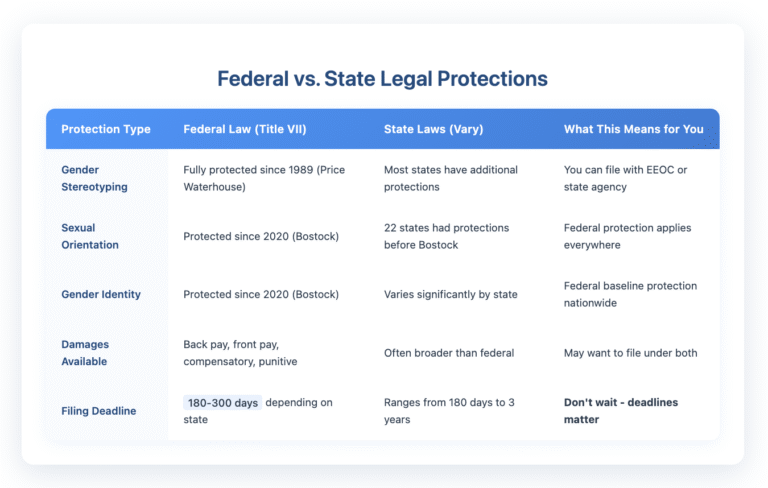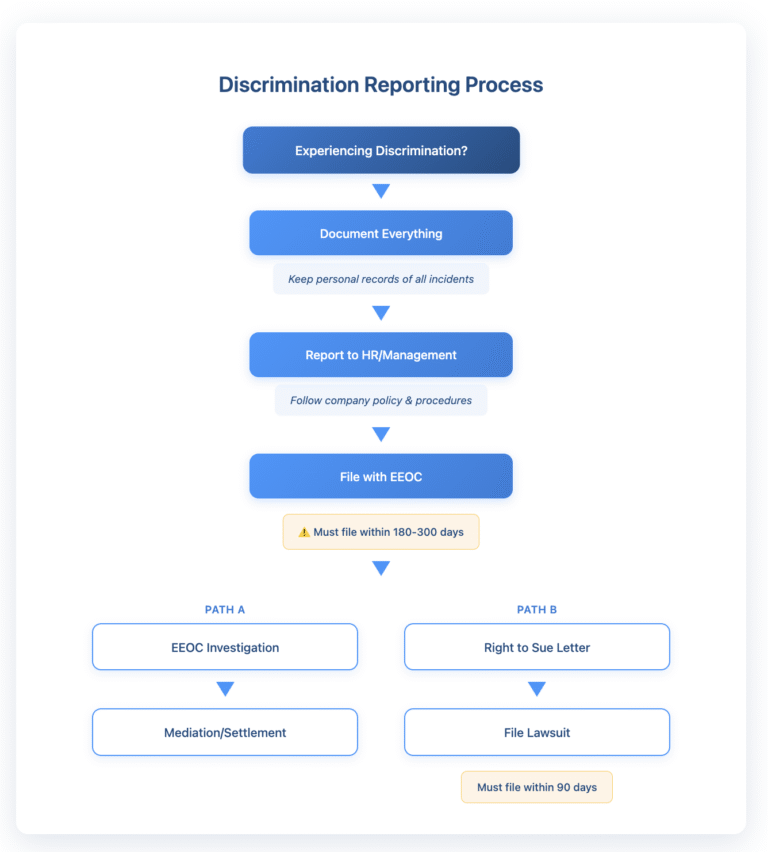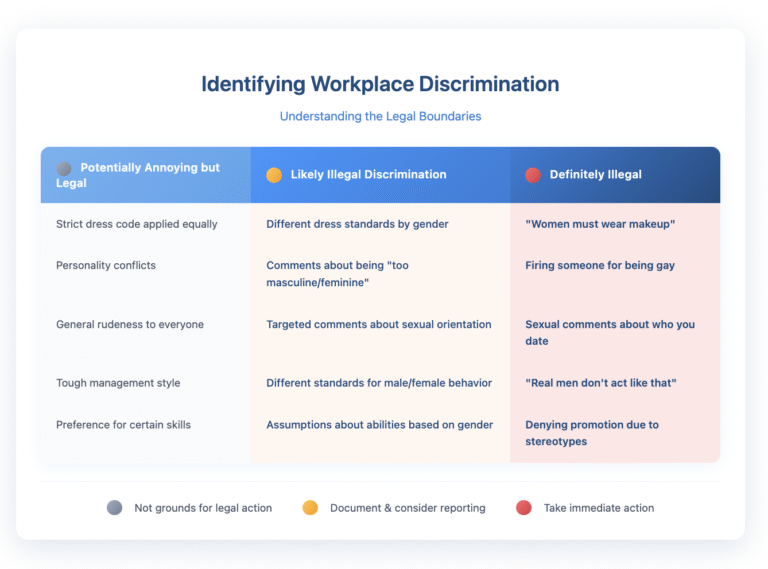If you’ve ever been told you’re “too masculine” for a woman, “not manly enough” for your job, or faced harassment because of who you love, you’re dealing with more than just workplace rudeness. You’re experiencing what the law recognizes as illegal discrimination. And yes, you have powerful legal protections on your side.
Here’s what you need to know: gender stereotyping and sexual orientation discrimination often go hand-in-hand in the workplace. The same laws that protect you from one often protect you from the other. Let’s break down exactly what these protections mean for you and how to use them.
Disclaimer: This article provides general information for informational purposes only and should not be considered a substitute for legal advice. It is essential to consult with an experienced employment lawyer at our law firm to discuss the specific facts of your case and understand your legal rights and options. This information does not create an attorney-client relationship.
What Gender Stereotyping Actually Looks Like at Work
Gender stereotyping happens when your employer makes decisions based on what they think someone of your gender “should” act like, look like, or be interested in. It’s not just about obvious discrimination—it’s often wrapped up in comments about your appearance, mannerisms, or personal life.
Think about these scenarios. A female mechanic gets passed over for promotion because her boss thinks customers won’t respect a woman in that role. A male nurse faces constant “jokes” about being in a “woman’s profession.” A woman in finance gets told she’s “too aggressive” while her male colleagues get praised for being “assertive” with the exact same behavior.
These aren’t just unfair situations—they’re illegal under federal law. Title VII of the Civil Rights Act prohibits employment discrimination based on sex, and courts have consistently ruled that this includes discrimination based on gender stereotypes.
The Legal Foundation: Price Waterhouse v. Hopkins
The landmark 1989 Supreme Court case Price Waterhouse v. Hopkins changed everything for gender stereotyping claims. Ann Hopkins was denied a partnership at an accounting firm despite bringing in more business than any other candidate. Why? Partners said she needed to “walk more femininely, talk more femininely, dress more femininely” and wear makeup.
The Supreme Court ruled this was illegal sex discrimination. The key takeaway? Your employer can’t punish you for not conforming to gender stereotypes. This applies whether you’re a woman who doesn’t wear makeup or a man who does.
How Sexual Orientation Discrimination Connects to Gender Stereotyping
Here’s where things get really important: sexual orientation discrimination and gender stereotyping are legally intertwined. When someone discriminates against you for being gay, lesbian, or bisexual, they’re often really discriminating against you for not conforming to their ideas about how your gender should behave—specifically, who you should be attracted to.
The Supreme Court made this crystal clear in Bostock v. Clayton County (2020). The Court ruled that firing someone for being gay or transgender violates Title VII’s prohibition on sex discrimination. Why? Because you can’t discriminate against someone for being attracted to men, for example, without considering that person’s sex.
Breaking Down the Bostock Decision
Let’s make this practical. Imagine two employees who both bring their spouses to the company picnic. Sarah brings her wife, and Steve brings his wife. If the company fires Sarah but not Steve, they’re discriminating based on Sarah’s sex—because the only difference is that Sarah is a woman married to a woman.
The Court’s logic was straightforward: discrimination against LGBTQ+ employees is inherently based on sex. You literally cannot discriminate against someone for being gay without taking their sex into account.

Common Forms of Gender Stereotyping You Might Not Recognize
Gender stereotyping isn’t always obvious. It often shows up in performance reviews, promotion decisions, and daily interactions that seem “normal” but aren’t. Understanding these patterns helps you recognize when you’re experiencing discrimination, not just “personality conflicts.”
Appearance-Based Discrimination
Your employer generally can have dress codes, but they can’t enforce them in discriminatory ways. A policy requiring “professional appearance” becomes illegal when it’s code for “conform to gender stereotypes.” For instance, requiring women to wear makeup while allowing men to come to work bare-faced? That’s gender stereotyping.
Similarly, penalizing a man for having long hair while allowing women to have long hair crosses the line. Unless there’s a legitimate safety reason (like machinery that could catch hair), different standards based on gender often violate the law.
Behavior and Personality Policing
This is where gender stereotyping gets really insidious. Women get labeled “bossy” or “difficult” for the same leadership behaviors that get men labeled “strong” or “decisive.” Men in caregiving professions face assumptions that they’re “not tough enough” or must be gay.
Performance reviews are where this often becomes documented evidence. If you’re seeing different standards applied based on gender—like women being told to “smile more” or men being criticized for being “too emotional”—that’s potential discrimination.
The Intersection Problem: When Multiple Biases Collide
Here’s something crucial to understand: discrimination rarely happens in neat categories. A masculine-presenting lesbian might face discrimination that’s simultaneously about her sexual orientation, her gender expression, and her failure to conform to feminine stereotypes. The law recognizes these intersecting forms of discrimination.
Courts have found that discrimination against someone for being a “masculine woman” or an “effeminate man” violates Title VII, regardless of that person’s actual sexual orientation. The discrimination itself is based on gender stereotyping, which is illegal.
Documentation Strategies That Actually Work
When you’re experiencing this kind of discrimination, documentation becomes your best friend. But random note-taking isn’t enough. You need a strategic approach that builds a clear picture of what’s happening.
Start by creating a discrimination log. Every incident gets recorded with five key pieces of information: date and time, location, people present, exactly what was said or done, and any witnesses. Use direct quotes when possible. “John said I need to be more ladylike” is much stronger than “John made a sexist comment.”

Understanding Hostile Work Environment Claims
Not all discrimination involves firing or demotion. Sometimes it’s about making your workplace so unbearable that you can’t do your job. That’s called a hostile work environment, and gender stereotyping often plays a central role.
For a hostile work environment claim based on gender stereotyping or sexual orientation, you need to show the harassment was: based on your sex (including stereotypes), unwelcome, severe or pervasive, and something your employer knew about (or should have known about) but didn’t fix.
“Severe or pervasive” is legal language that basically means either really bad (severe) or happening all the time (pervasive). One extremely offensive incident might be enough, or a pattern of smaller incidents over time.
What Counts as “Severe or Pervasive”
Let’s get specific. A supervisor repeatedly calling a gay employee “princess” or “sweetheart” in a mocking tone? That could be pervasive harassment based on gender stereotypes. Colleagues constantly question whether a female construction worker can “handle the physical demands” despite her proven ability. That’s gender stereotyping that could create a hostile environment.
The key is showing a pattern or practice that a reasonable person would find hostile or abusive. One offhand comment probably isn’t enough, but you don’t need to endure years of abuse before taking action either.
Your Rights During the Investigation Process
Once you report discrimination, your employer has a legal obligation to investigate. This isn’t optional—they must take your complaint seriously and conduct a prompt, thorough investigation. During this time, you have specific rights that protect you.
First, you have the right to be free from retaliation. Your employer cannot punish you for reporting discrimination, even if the investigation doesn’t substantiate your claims. Retaliation can include obvious things like firing or demotion, but also subtler actions like changing your schedule, excluding you from meetings, or giving you worse assignments.
Second, you have the right to have your complaint taken seriously. If your employer’s “investigation” consists of asking the accused person, “Did you do it?” and accepting their denial, that’s not adequate.

Building Your Case: Evidence That Matters
If you’re thinking about taking legal action, certain types of evidence carry more weight than others. Written evidence is gold—emails, texts, performance reviews, company policies. If someone puts their discrimination in writing, they’ve done half your work for you.
Comparator evidence is also powerful. This means showing that people of a different gender or sexual orientation were treated better in similar situations. If straight employees can talk about their spouses but you get written up for mentioning your same-sex partner, that’s comparator evidence.
Witness testimony matters too, but remember—not everyone who sees discrimination will be willing to testify about it. People worry about their own jobs. That’s why contemporary documentation is so important. Writing down what witnesses said right after they said it preserves that evidence even if they later get cold feet.
The EEOC Process: What to Expect
Filing with the Equal Employment Opportunity Commission (EEOC) is usually your first formal legal step. You typically have 180 days from the discrimination to file, though some states extend this to 300 days. Don’t wait—these deadlines are strict.
The EEOC will notify your employer and may attempt mediation. If mediation fails, they investigate. This can take months or even over a year. Eventually, they’ll either issue a determination (finding discrimination did or didn’t occur) or a right-to-sue letter that lets you file a lawsuit.
During the EEOC process, keep documenting any ongoing discrimination or retaliation. The EEOC investigation doesn’t pause the statute of limitations on new incidents.
State Law Protections: Going Beyond Federal Minimums
While federal law now protects against sexual orientation and gender identity discrimination everywhere, many states offer additional protections that might benefit your case. Some states allow longer filing periods, higher damage awards, or coverage for smaller employers (federal law only covers employers with 15+ employees).
New York, California, and several other states explicitly prohibit discrimination based on gender expression and have done so for years before Bostock. These states often have more developed case law that can strengthen your claims.
When Gender Stereotyping Affects Your Career Path
Discrimination doesn’t always look like harassment. Sometimes it’s about the opportunities you don’t get. Women in male-dominated fields often find themselves steered toward “softer” roles—the female engineer assigned to customer relations instead of technical design, for instance.
Men face this too, especially in fields like education or nursing. Male teachers report being warned against being “too friendly” with students in ways their female colleagues aren’t, or being passed over for elementary positions in favor of high school jobs because young children “need female teachers.”
These steering practices based on gender stereotypes are illegal, but they’re harder to prove because they involve decisions not made rather than actions taken. This is where pattern evidence becomes crucial—showing that gender-nonconforming employees consistently get different opportunities than those who fit stereotypes.
Next Steps: Protecting Yourself and Your Career
If you’re experiencing gender stereotyping or sexual orientation discrimination, you don’t have to figure this out alone. Start documenting everything now, even if you’re not sure you’ll take legal action. Good documentation preserves your options.
Review your employee handbook and follow your company’s complaint procedures. This accomplishes two things: it gives your employer a chance to fix the problem (which they’re legally required to do once notified), and it protects you from any argument that you didn’t follow proper channels.
Consider whether you need immediate legal counsel. If you’re facing termination, significant harassment, or retaliation for reporting discrimination, don’t wait. Legal deadlines are unforgiving, and early intervention often leads to better outcomes.
Taking Action: Your Path Forward
You have more power than you might realize. The law is on your side when it comes to gender stereotyping and sexual orientation discrimination. The key is understanding your rights and acting strategically to protect them.
Remember, discrimination based on gender stereotypes or sexual orientation isn’t just unfair—it’s illegal. Whether you’re facing subtle bias in performance reviews or explicit harassment, you have legal options.
If you’re experiencing workplace discrimination based on gender stereotypes or sexual orientation, Nisar Law Group can help you understand your rights and options. Contact us for a consultation to discuss your specific situation and develop a strategy that protects your career and your dignity. You don’t have to navigate this alone—let’s talk about how to move forward.


